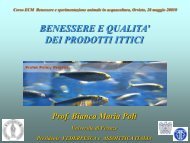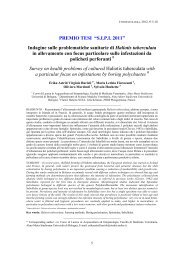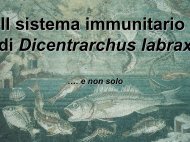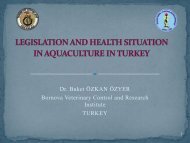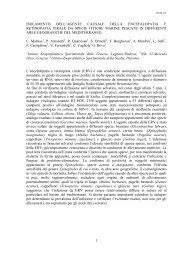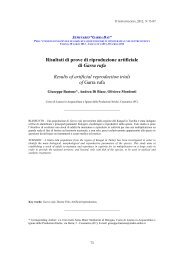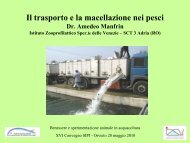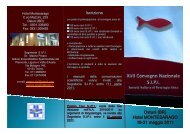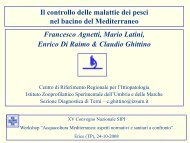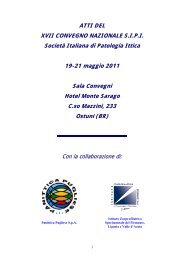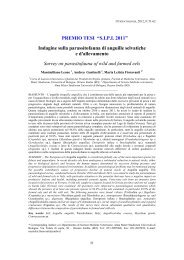ATTI DEL XV CONVEGNO NAZIONALE SIPI Società Italiana di ...
ATTI DEL XV CONVEGNO NAZIONALE SIPI Società Italiana di ...
ATTI DEL XV CONVEGNO NAZIONALE SIPI Società Italiana di ...
- No tags were found...
Create successful ePaper yourself
Turn your PDF publications into a flip-book with our unique Google optimized e-Paper software.
Abstract Workshop<br />
LEGISLATION AND HEALTH SITUATION IN AQUACULTURE IN TURKEY<br />
Buket OZKAN OZYER<br />
Bornova Veterinary Control and Research Institute<br />
Introduction<br />
Turkey is surrounded on three sides by Me<strong>di</strong>terranean Sea , Agean Sea and Black Sea and<br />
has a big potential for aquaculture. Total lenght of Turkish coastlines are 8 333 km. The<br />
country has also rich inland waters that are 200 lakes, 159 dams lakes and 750 small dam<br />
lakes or ponds, and river systems (33 rivers) with significant capture fishery and<br />
aquaculture potential.<br />
Aquaculture is a new industry for Turkey in comparison with other farm animals.<br />
Aquaculture in Turkey was started with rainbow trout in 1970s. Approximately ten years<br />
later sea bass and sea bream were begin to produce in 1980s. Aquaculture is currently<br />
becoming even more popular and is a very impotant sector in Turkey.<br />
The percapita consumption of fishery products in Turkey is around 7 kg which is quite<br />
low in comparison to global and European average figures when compared to Turkey‟s<br />
available aquatic resources.<br />
Total fish production in Turkey is 701,395 tons in 2007 inclu<strong>di</strong>ng cultured and catch fish.<br />
Cultured fish production is 139,873 tons which is 19.9 % of total production. Total number<br />
of fresh water fish farms registrated by Ministry are 1 281 and total cultured fresh water<br />
fish production is 59,033 tons in 2007. The main cultured fresh water fish are rainbow<br />
trout (98,98 % total cultured fresh water fish) and comman carp. Total number of marine<br />
fish farms registrated by Ministry are 352 and total cultured marine fish production is<br />
80,840 tons in 2007 . The main cultured marine fish are sea bass and sea bream.<br />
Ad<strong>di</strong>tionally, a few farms are making trials for rearing new species such as tuna, turbot,<br />
conger eel, sharpsnout seabream, waker, mearge, croaker, dentex, brown mearge and<br />
common seabream.<br />
Total number of registrated by Ministry bivalve mollusc farms are 3 and total cultured<br />
bivalve mollusc production is 1,100 tons. Total number of catch bivalve mollusc is 50,146<br />
tons in 2007. The main bivalve mollusc species are carpet shell, striped venus,<br />
me<strong>di</strong>terranean mussel, beared horse mussel and warty venus.<br />
Common Fish Diseases -<br />
Marine fish <strong>di</strong>seases<br />
Main bacterial <strong>di</strong>seases of sea bass and seabream are vibriosis which caused by Listonella<br />
anguillarum and other vibrio sp. and pasteurellosis caused by Photobacterium damsela<br />
subsp. pisci<strong>di</strong>a. Other bacterial <strong>di</strong>seases are myxobacteriosis (Tenacibaculum maritimum),<br />
streptococcosis (Streptococcus iniae, Streptococcus uberis), motil aeromonas septicaemia<br />
(Aeromonas hydrophilia), winter <strong>di</strong>seases (Pseudomonas anguilliseptica) and clami<strong>di</strong>osis<br />
(clami<strong>di</strong>a like organism).<br />
Main viral <strong>di</strong>seases; Lymphocystis is comman all juvenil sea bream. The <strong>di</strong>agnosis of<br />
lymphocystis is based on clinical sign and macroscopical aspect. IPNV was isolated from<br />
sea bass on two farms in black sea. Diagnosis of VNN has been just started in laboratory.<br />
Accor<strong>di</strong>ng to Turkish Statistical Institute<br />
Accor<strong>di</strong>ng to Ministry of Agriculture and Rural Affairs<br />
70



